- Title Page
- Copyright Page
- Contents
- Preface
- Acknowledgements
- Chapter 1: Setting Up Shop
- Chapter 2: Metals, Alloys, Oils & Hardness Testing
- Chapter 3: Tapers, Dowel Pins, Fasteners & Key Concepts
- Chapter 4: Filing & Grinding
- Chapter 5: Drilling, Reaming & Tapping
- Chapter 6: Bandsaws
- Chapter 7: Lathes
- Chapter 8: Milling Machines
- Chapter 9: Machine Shop Know How
- Index
- Credits
Chapter 4
Filing & Grinding
The purpose of education is to replace an empty mind with an open one.
—Malcolm Forbes
Section I – Filing Basics
Introduction
Hammers, cold chisels and punches are blacksmith tools adopted by machinists, but files are the machinists’ first and most basic tool. Since 1100 years bc, crude files in the form of stones with ridges running at right angles across them were used for the same purpose as modern files—to sharpen tool edges. The first attempt to make files by machine began in 1490, but the first successful production began in France in 1750. Before the development of machine tools, files were the only way to precisely cut and shape metal. With skill and patience, early machinists made clocks and locks using just files.
Files are inexpensive, portable and able to fit into tight spots, but because today there are faster methods to remove metal, files are mainly used to sharpen, smooth edges, remove burrs, or to make fine adjustments. Still, they remain an important and handy tool, indispensable to mold makers, tool and die makers, prototype makers and to gunsmiths.
File Terms
Figure 4-1 shows the parts of a file.

Figure 4-1. The parts of a file.
- A file’s safe edges are smooth and have no teeth, allowing the file to cut on one surface but not on an adjoining one. See Figure 4-2. Although most files are not manufactured with safe edges, they can be applied by grinding off the teeth on an edge or face of a file using a belt, disc, pedestal or surface grinder.

Figure 4-2. A file with a safe edge (left) and one with teeth on its edge (right).
- Single-cut files have diagonal rows of teeth running across the width of the file. They are used with light pressure for a smooth finish with limited metal removal. See Figure 4-3 (top).
- Double-cut files have two diagonal rows of teeth running in opposite directions across the width of the file. They remove metal faster than single-cut files, but leave a rougher surface. See Figure 4-3 (bottom).

Figure 4-3. Single-cut file (top) and double-cut file (bottom).
File Cut Shapes
Figure 4-4 shows the many shapes files can create.
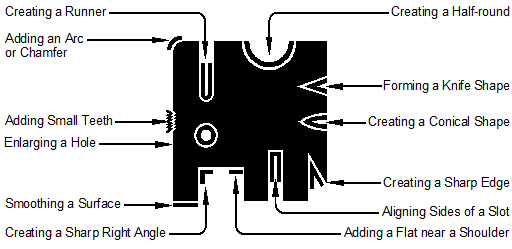
Figure 4-4. File cut shapes.
Swiss- and American-Pattern Files
- American-pattern files, sometimes called engineers’ files, are the most common full-size files seen in machine shops. They remove metal rapidly and are available with both single and double cuts.
- Most American-pattern files are only available in three grades of cut—bastard, second and smooth—while Swiss-pattern files, also known as needle files, are available in eight grades. American-pattern file cut grades roughly correspond to the following Swiss-pattern grades:
- Bastard cut is equivalent to Swiss-pattern cut 00.
- Second cut is equivalent to Swiss-pattern cut 2.
- Smooth cut is equivalent to Swiss-pattern cut 6.
There are no American-pattern equivalents to the other five Swiss-pattern cuts, but this is not a problem because American-pattern files are used mainly for faster metal removal on rougher, larger workpieces.
- The smaller Swiss-pattern files are for more precise work and for minute adjustments, so they are available only in single-cut. Note that the terms single-cut and double-cut refer only to the number of rows of teeth, not to the number of teeth per inch. However, very fine files with high teeth per inch are not supplied in double-cut designs because that would defeat the purpose of making a file with a high tooth count—to slowly remove small, precise amounts of metal.
- The number of teeth per inch increases with decreasing file length since, proportionately, less metal is removed with a small file than with a large one. Table 4-1 shows the scale of file cut grades for Swiss-pattern files.
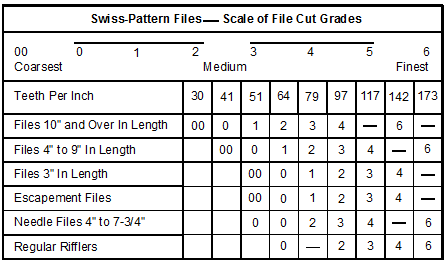
Table 4-1. Swiss-pattern file cut grades.
Section II – File Designs
File Categories
- American-pattern or engineers’ files are available in 4, 6, 8, 10, 12, 14 and sometimes 16-inch lengths. They are the most common of all files, and come in a variety of shapes. See Figure 4-5. A properly-stored, readily accessible, good selection of these files is essential for every shop.
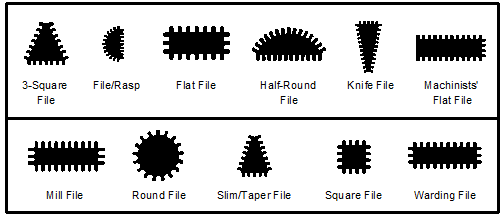
Figure 4-5. Common American-pattern file shapes.
- Precision files are ideal for “in-between” jobs that are too large for Swiss-pattern files and too big for American-pattern files. Precision files are typically 4-inches in length and have up to 400 teeth per inch that cut all the way to their tips. These files are manufactured with more uniformity than their larger American-pattern cousins, so the user will get consistent results year after year. Most precision files are single cut in keeping with their purpose, the precise, slow removal of metal, but a few precision file shapes are available in double-cut. See Figure 4-6 for a sampling of the many precision file shapes.

Courtesy of Usines Métallurgiques de Vallorbe SA
Figure 4-6. Precision files.
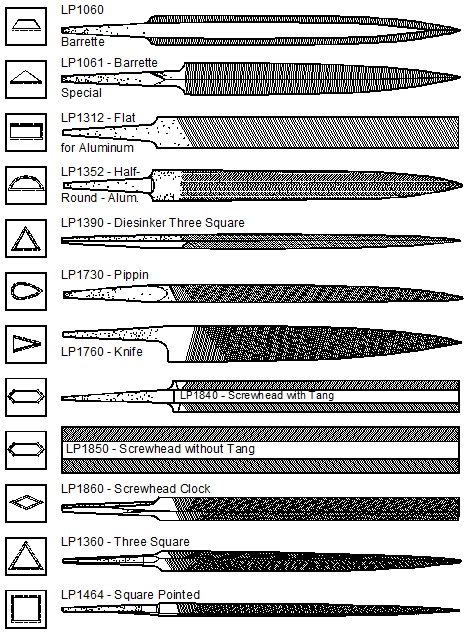
Courtesy of Usines Métallurgiques de Vallorbe SA
Figure 4-6. (continued) Precision files.
- Needle files, also known as Swiss-pattern files, are used by watchmakers, instrument makers, mold makers and gunsmiths for finishing small, delicate, intricate parts, not for removing metal rapidly. See Figure 4-7. Swiss-pattern files are single-cut. They come in many lengths, but the 3- and 4-inch sizes are the most popular. Some needle files have dipped vinyl handles and others have handles that are simply round rods with knurling. Many users insert needle files in a pin vise or other holder to increase control and reduce operator fatigue. Needle files are also available with diamond-coated surfaces instead of teeth. These files can make fine adjustments on hard materials, including carbides, tool steels and glass.
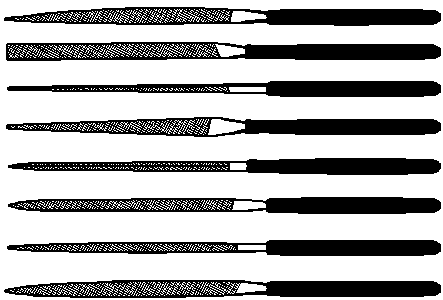
Figure 4-7. Needle files, or Swiss-pattern files, with dipped vinyl handles.
- Escapement files have safe edges and are specifically designed for intricate clock making and repair. They are available in many different shapes. For a sampling, see Figure 4-8.

Courtesy of Usines Métallurgiques de Vallorbe SA
Figure 4-8. Escapement files.
- Rifflers, also known as die sinkers, are double-ended files with a 6-inch overall length. Both of their ends have teeth with a handle between them. Their long, thin shape allows rifflers access to very tight spaces such as the inside or bottom of cavities, making rifflers a favorite of mold makers. See Figure 4-9 for some of the many riffler shapes.

Courtesy of Usines Métallurgiques de Vallorbe SA
Figure 4-9. Rifflers and their cutting profiles.
- Warding, or locksmiths’ files, are scaled down versions of engineers’ files. They are used for smaller work than the typical engineers’ files, but larger work than that requiring the smaller, more precise and expensive needle files or rifflers. See Figure 4-10.
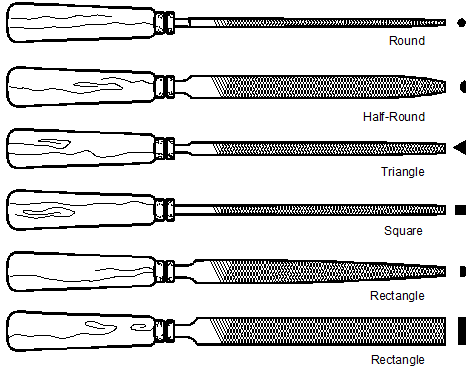
Figure 4-10. Warding, or locksmiths’ files, and their cutting profiles.
Specialty Files
- Long-angled, or lathe files, have teeth set at 45° to the file’s length instead of the usual 65°. They are designed for lathe filing most metals and for bench filing aluminum and copper alloys. The single-cut bastard teeth are self-clearing when used at right angles to the work. They cut cleanly without chatter and do not drag or tear. Lathe files have a rectangular cross section, taper slightly in width toward the point, and both edges are safe to protect the shoulders of work not to be filed. In the lathe, the file should not be held rigidly or stationary, but constantly stroked. A slight gliding or lateral motion assists the file to clear itself and to eliminate ridges and grooves. Use a long steady stroke across the work and move laterally about half the width of the file. Lathe filing is most often used to remove sharp edges from shoulders and for sizing shafts when only a little material needs to be removed. When lathe filing must be performed with a conventional file (65° teeth), hold the file at a 20° angle clockwise to the lathe axis as in Figure 4-11. This will place the conventional file teeth at 45° to the work as a lathe file does. When lathe filing, fill the file grooves with blackboard chalk to improve the surface finish of the work. Run the lathe at the same speed as for turning the same metal. Uneven pressure on the file and excessive use of lathe filing leads to an out-of-round condition on the work.

Figure 4-11. Long-angled or lathe files have teeth at 45º instead of the usual 65º angle.
- A Three-square file is an engineers’ file used to file acute angles, grooves, corners and notches. Its triangular cross section, while similar to a taper saw blade sharpening file, has three sharp edges used for bringing rounded inside corners to square. See Figure 4-12.
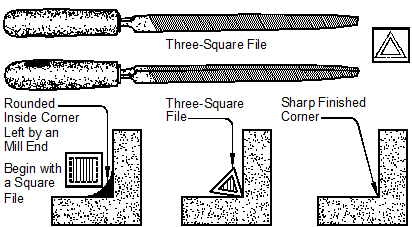
Figure 4-12. A square file begins removal of the corner web left by an end mill, and
a three-square file removes the remaining metal to leave a square inside corner.
- Tungsten carbide files are excellent for rough work on hard phenolic plastics like electrical switch plates, and for filing work with both hardened and unhardened surfaces such as welds that must be blended with the rest of a workpiece surface. See Figure 4-13.

Figure 4-13. A coating of tungsten carbide particles produces a file for hard materials.
- Rasps and curved-tooth files work well on lead, leather, plastics and some softer zinc castings. When used on soft materials, they resist loading. See Figure 4-14.
 Figure 4-14. Rasp (top) and curved-tooth file (bottom).
Figure 4-14. Rasp (top) and curved-tooth file (bottom).
Section III – Filing Practice
Important File Practices
- Never use a tanged file without a handle, especially when doing lathe work. The tang can push through your palm.
- Always lighten up pressure on the file when pulling with the direction of its teeth. The file will last longer and cut better.
- Never hammer a file on its point to seat it into its handle. Invert the file in its handle, then rap the file handle top on a hard surface.
- Avoid cross contamination of workpieces of different metals by removing particles caught in file teeth. With American-pattern files, use a file card that has steel wire bristles on a wooden handle, and with precision and Swiss-pattern files, use a new stainless steel wire brush. A file card will not work with precision or Swiss-pattern files because the card’s wires are too large to fit into the small teeth of these files. See Figure 4-15. Stubborn metal particles can also be removed from file teeth using the edge of the mouth of a soft brass cartridge case, a piece of hardwood, or a soft iron point.
- Apply white blackboard chalk to lathe files to prevent metal filings from adhering to the file teeth and leaving marks from them on the work.
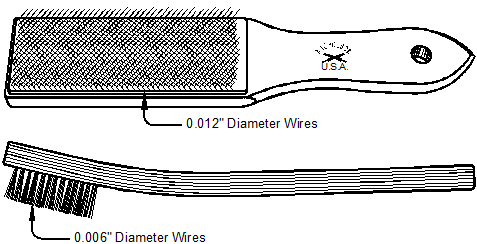
Figure 4-15. Use a file card (top) on American-pattern files, also called engineers’ files, and a stainless steel wire brush (bottom) on precision and Swiss-pattern files, also called needle files, to match the wire size to the file teeth spacing.
Bent Files
Files can be easily bent to fit into tight spots or to permit flat filing as in Figure 4-16. Heat the bend point red hot with an oxyacetylene torch, bend the file to shape while holding the hot end in pliers, then quench in water to re-harden the file. Place the pliers at the desired point of the bend or the bend will not be sharp, but rounded.
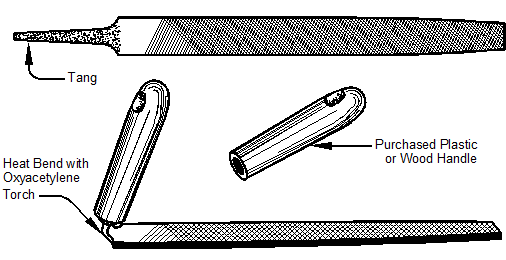
Figure 4-16. Bending the file handle permits the filing of flat surfaces.

